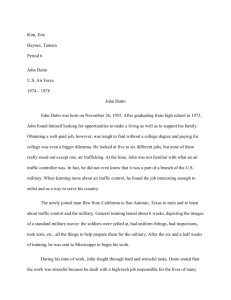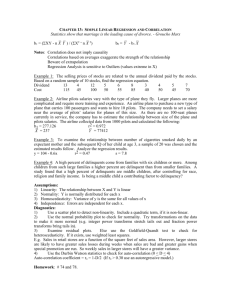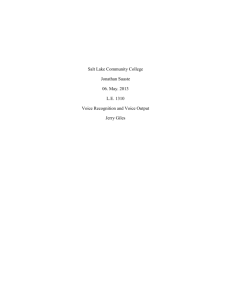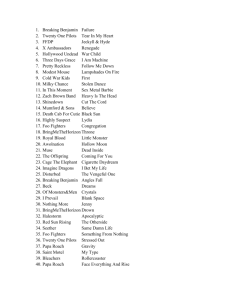Decisions at Littlefield – A Pilot`s view
advertisement
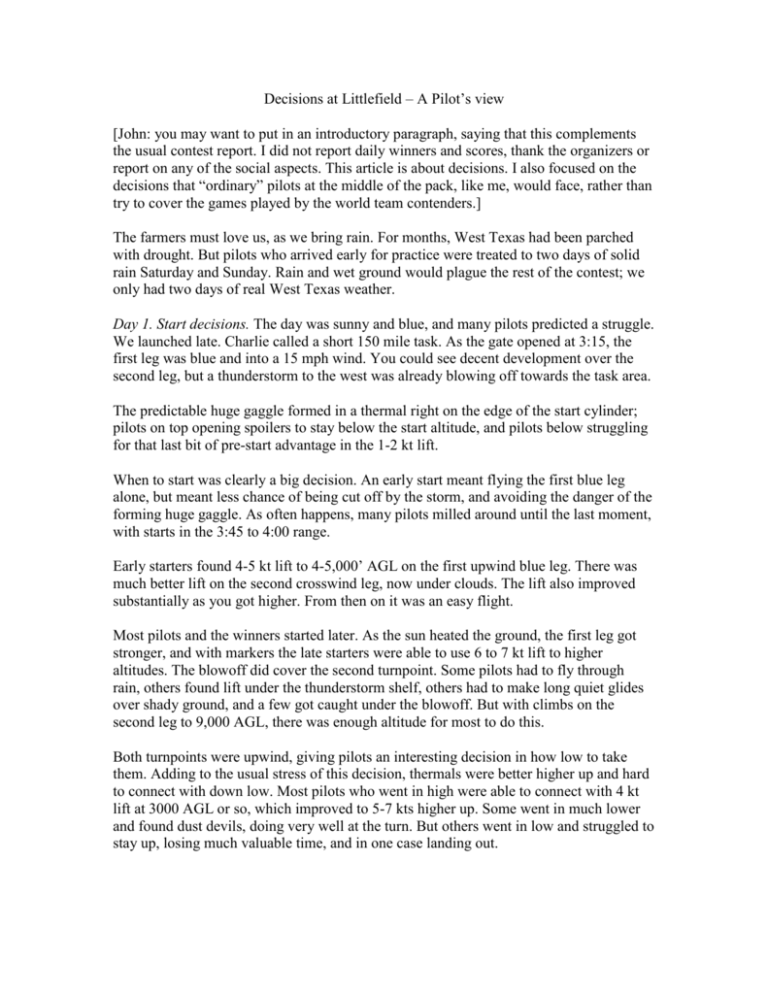
Decisions at Littlefield – A Pilot’s view [John: you may want to put in an introductory paragraph, saying that this complements the usual contest report. I did not report daily winners and scores, thank the organizers or report on any of the social aspects. This article is about decisions. I also focused on the decisions that “ordinary” pilots at the middle of the pack, like me, would face, rather than try to cover the games played by the world team contenders.] The farmers must love us, as we bring rain. For months, West Texas had been parched with drought. But pilots who arrived early for practice were treated to two days of solid rain Saturday and Sunday. Rain and wet ground would plague the rest of the contest; we only had two days of real West Texas weather. Day 1. Start decisions. The day was sunny and blue, and many pilots predicted a struggle. We launched late. Charlie called a short 150 mile task. As the gate opened at 3:15, the first leg was blue and into a 15 mph wind. You could see decent development over the second leg, but a thunderstorm to the west was already blowing off towards the task area. The predictable huge gaggle formed in a thermal right on the edge of the start cylinder; pilots on top opening spoilers to stay below the start altitude, and pilots below struggling for that last bit of pre-start advantage in the 1-2 kt lift. When to start was clearly a big decision. An early start meant flying the first blue leg alone, but meant less chance of being cut off by the storm, and avoiding the danger of the forming huge gaggle. As often happens, many pilots milled around until the last moment, with starts in the 3:45 to 4:00 range. Early starters found 4-5 kt lift to 4-5,000’ AGL on the first upwind blue leg. There was much better lift on the second crosswind leg, now under clouds. The lift also improved substantially as you got higher. From then on it was an easy flight. Most pilots and the winners started later. As the sun heated the ground, the first leg got stronger, and with markers the late starters were able to use 6 to 7 kt lift to higher altitudes. The blowoff did cover the second turnpoint. Some pilots had to fly through rain, others found lift under the thunderstorm shelf, others had to make long quiet glides over shady ground, and a few got caught under the blowoff. But with climbs on the second leg to 9,000 AGL, there was enough altitude for most to do this. Both turnpoints were upwind, giving pilots an interesting decision in how low to take them. Adding to the usual stress of this decision, thermals were better higher up and hard to connect with down low. Most pilots who went in high were able to connect with 4 kt lift at 3000 AGL or so, which improved to 5-7 kts higher up. Some went in much lower and found dust devils, doing very well at the turn. But others went in low and struggled to stay up, losing much valuable time, and in one case landing out. Day 2. Get home. The day started with overcast from a passing cold front. It slowly cleared, and the Texas sun will cook thermals from icebergs. The first leg was easy with beautiful clouds and 7 knot thermals. Later starters were able to make up some time using markers. At the first turn things got a little weak, and the terrain was not very hospitable. Lots of gliders were putzing around in rough poorly formed thermals, looking for a good climb before pushing on. More aggressive pilots pressed on and found the good 6-7 knot thermal halfway down the second leg much faster than the rest of us. And here the day started. The second half of the second leg was totally blue, as a thunderstorm had drenched the area the day before. Most pilots had long smooth 25 mile 70 kt glides into the wind. Then came a long struggle home in light choppy thermals over wet ground. East Coast pilots felt right at home, working ground sources to 2,000 feet AGL. At least it was down a strong wind. Most of the field ended up strung out along the last leg. The key for a decent score was simple – make it home! The winner ignored the start game, headed out first and did not get caught. Knowing when to make this gamble is a great art. Day 3. Psychology. This started as the most promising day so far. At last no overcast in the morning. Cu were soon popping over the airport, and then popping much too much. Charlie’s first call of a PST with first turn West would have sent us right in to a developing storm. A quick task change sent us North to more promising sky, but blowoff from the storm to the West threatened the first leg. Most pilots sensed the danger and left immediately. The storm blowoff soon covered the area around the first turnpoint. Most pilots were able to make the first turn, but the next leg was back into a 20 kt wind under the blowoff. Most of the field landed along this leg. A few pilots made the second turn and most of the way home. The rest of us learned from their experiences. They made a substantial detour out to the East of the course line. This brought them towards if not sun, at least ground that had more recently seen sun. The straight course promised airports along the way, so this swing meant committing to a field landing if things went wrong. It really helps to have a dedicated crew in weather like this! More importantly, they did not get into survival mode too quickly. There were still 2-3 kt thermals under the thunderstorm blowoff; heated ground stays hot for a while even after the sun is cut off. By keeping going, between 1,000 and no more than 3,000 feet, and working in groups, these pilots made it quickly under the blowoff and back to the sunlight, where they found good 6 kt thermals again. Weak days test psychology. It is hard to avoid the great sucking sound of an airport that already has 10 gliders on it, and it is hard to change gears down just enough to stay airborne, but not so much that you lose the race against deteriorating weather. I think many of us either said “oh well the day is over” and gave up, or went into ultra survival mode, taking too weak lift and then getting overtaken by bad weather. The day ended with a huge rainstorm – just what we need, more water on the ground! With a horrible forecast, water everywhere and tired pilots, many from two consecutive muddy retrieves, Charlie did the only sensible thing and called a rest day. Day 4. Shaving circles and staying out of trouble. After a rest day, I woke up and smelled sage; the air was dry and the sky blue. The day was terrific; just the kind of weather we drive to Texas to enjoy. Most thermals were better than 6 knots, and quite a few were 8 and above. The scale of Western flying takes a little getting used to. You can glide 40 miles between thermals, but from 10,000 feet that’s not hard to do. The thermals are surrounded by lots of junk air that can tempt an East Coast pilot to needless turns. You have to sniff out the characteristic smoothness of the really good lift. The big pack started late and had a classic day of racing. Playing the strategic games right, shaving a few circles here and there, and using markers to avoid 4 kt lift and use only 7 kt lift made the difference between first place in the mid 80s and 20th place in the high 70’s. Afterwards, the winners commented on how important it had been to start right and work in a group. However, there were traps for the unwary. The first lift was quite a bit down the courseline. Some pilots pressed too hard or chose a poor route, and had to struggle right away. The second turnpoint at Hobbs was weak. Many pilots either pressed a little too much or chose an unwise course, and wound up wasting valuable time getting going again. Day 5. PST. Charlie made a perfect PST call. An hour after the start a storm developed out of the blue, right in the middle of the task area. Just about any AST would have brought pilots into the storm, or at least into the dead air around it. The PST let us stay where the weather was good. Some of the thermals were astounding. I saw 11 knots on the averager and 16,300 feet. Of course with storms, outflow and gust fronts, blue areas, spotty overdevelopment, wet ground, and a day that switched off like a light ½ hour before the task ended, there were plenty of traps for the unwary! The only decision on a PST task is where to go. Most pilots stayed west of the rain in a nice band of clouds. Some went north to promising looking clouds, but the wet farm land meant the day ended a half hour earlier there. Coming back towards the airport and working close-in turnpoints was not an option, as all could see the huge blue hole centered around Littlefield. The day was a good one to keep in mind in thinking about the PST. The PST saved the day. It kept us in good weather. Calling time rather than distance allows all pilots to use the day to its fullest. On the other hand, the day turned in to a slight overcall. The optimum time to come home was about 3:10 of a 3:30 call. There were many landouts among pilots who made the daring decision to keep going rather than finish 15 or 20 minutes early, and the vast majority finished early. A scoring system that does not have a rigid minimum time, but gives smooth incentives to keep flying longer would have worked even better on this beautiful but challenging day. Day 6. Rain. We had sat out two days, and were anxious to get another day in. There were cumulus at about 3,000 feet and lots of higher clouds. By task open, we could see rain coming to the field from the North. The task was a short triangle to the south. The main decision was whether to start immediately, trying to beat possible bad weather, or hang back on the hope that it would be a race. In the end it didn’t matter. The early starters had to work alone. The main pack started about 20 minutes later and caught them by the second turn. The last leg was very weak. About halfway down the last leg, we ran in to the outflow from the storm over the field. Everyone landed where they ran into the outflow, typically between 10 and 20 miles from the airport. Had we all started right away, most would have made it home. But the decision to play start gate roulette, under current rules, was the right one for each individual pilot. Had the storm come 5 minutes later, late starters would have gained 20 minutes or more on the early starters by using markers. Littlefield is a great area to fly. It has the safest terrain I have ever seen. It’s even better than the Midwest, because the crops are not corn, so most fields are clear in late June. When the weather is good, it’s shockingly good. Most days ended with a beautiful sunset, an orange sun lighting high clouds from below in the awe-inspiring vastness of the Texas sky and landscape. The plans to open Reese center, an ex-airforce base near the amenities of Lubbock rather than the spartan (and dry!) Littlefield, will give us another soaring Mecca.
